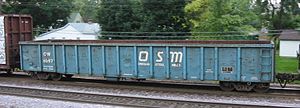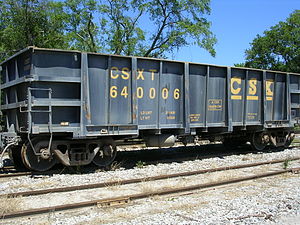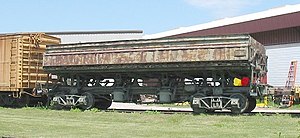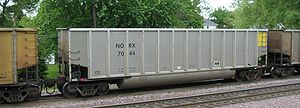|
|
| (27 intermediate revisions by the same user not shown) |
| Line 1: |
Line 1: |
| − | ''For Jay Leno's bespoke [[tank]]-engined car, see the [[Blastolene Special]].''
| + | {{otheruses|Gondola (disambiguation)}} |
| − | | + | [[Image:CW 5097 at Rochelle, IL, 20040718.jpg|thumb|300px|A railroad gondola seen at [[Rochelle, Illinois]].]] |
| − | [[Image:UTLX 204455 20050529 IL Rochelle.jpg|thumb|300px|A modern tank car, owned by the [[Union Tank Car Company]], passes westbound through [[Rochelle Railroad Park]], [[Rochelle, Illinois]] on [[May 29]], [[2005]].]] | + | In [[railroad terminology]], a '''gondola''' is an open-top type of [[rolling stock]] that is used for carrying loose bulk materials. Because of its low side walls, gondolas are used to carry either very dense material, such as [[steel]] plates or coils, or bulky items such as prefabricated pieces of [[rail track]]. |
| − | | |
| − | A '''tank car''' is a piece of [[railroad]] [[rolling stock]] designed to carry [[Bulk liquids|liquefied loads]], [[petroleum]] products, liquid [[chemicals]] and [[gas]]es. In the [[United Kingdom]] and countries that follow their railway practices tank cars are generally called '''tank wagons''' or '''tanker wagons'''.
| |
| | | | |
| | ==History== | | ==History== |
| − | <gallery>
| + | Before the opening of the [[Baltimore & Ohio Railroad]] and the [[Chesapeake & Ohio Canal]] in Harpers Ferry (West Virginia née Virginia), considerable amounts of [[coal]] were carried via the Potomac River. Since timber was an abundant resource, flat boats, called “[[gondolas]]” (a spoof on Venetian rowing boats), were constructed to navigate the "black diamonds" down river to markets around Washington, DC. There, both the boat and cargo were sold and the boatmen returned home by foot. The railroad cars first employed in the haulage of coal were thus named after these shallow-draft boats called “gondola cars.” |
| − | Image:RR-1331.jpg|The narrow domes on these [[East Tennessee and Western North Carolina Railroad]] tank cars mirror the designs of the first all-steel units.
| |
| − | Image:OP-16233.jpg|This double-dome tank car has two separate interior tanks, which allow different products to be transported in the same car.
| |
| − | Image:OP-19582.jpg|This unusual three-dome tank car has an oversized center dome.
| |
| − | </gallery>
| |
| | | | |
| − | [[Image:Carro cisterno de Ferrovie Eritrea.jpg|thumb|A ''carro cisterna'' (tank car) of the [[Eritrean Railway]] (''Ferrovia Eritrea'', or ''FE''), date unknown. The 2-axle car is 7,000 mm (23 ft) long, and has a 6,650 kg (14,660 [[pound (mass)|lb]]) load capacity.]]
| + | Early gondola cars typically had low sides. Their contents had to be shoveled out by hand and they took a long time to unload. In 1905, the [[Ralston Steel Car Company]] patented a flat bottom gondola with lever operated chutes that allowed the gondola to be unloaded automatically from the bottom. The chutes would direct the contents of the gondola to the sides. This coincided with the switch from wood to steel freight cars as the pulling force of locomotives tended to crush the older wood cars. |
| | | | |
| − | The first tank built in the United States was in Pennsylvania to move petroleum. It consisted of three open vats bolted to a flat car. The problem came as tank car design and liquid cargo types expanded. Investing in new cars all the time made tank cars unappealing to railways, so a new company was founded: [[Union Tank Car Company]]. this company was charged with building, maintaining and running, on behalf of the railways, the tank car fleet.
| + | ==Specialized car types== |
| | + | ===[[Coil car (rail)]]=== |
| | + | ===Lorry===<!-- This section is linked from [[Railroad car]] --> |
| | + | Or '''tippler''' (UK) |
| | + | An open railroad car (gondola) with a tipping trough, often found in [[mining|mines]]. |
| | | | |
| − | * 1865: Flats with banded wooden tanks mounted on top are employed for the first time to transport crude oil from the fields of [[Pennsylvania]].
| + | ===[[Track ballast]] gondolas=== |
| − | * 1869: Cast iron tanks (with an approximate capacity of 3,500 gallons / 13,200 l per car) replace wooden tanks.
| + | [[Image:Side dump gondola at NRM.jpg|thumb|A side-dump gondola on display at the [[National Railroad Museum]], [[Green Bay, Wisconsin]].]] |
| − | * 1888: Tank car manufacturers sell units directly to the oil companies, with capacities ranging from 6,000 gallons to 10,000 gallons (22,700 l to 37,800 l).
| + | {{-}} |
| − | * 1903: Tank car companies develop construction safety standards; more than 10,000 tank cars are in operation.
| |
| − | * 1915: A classification system is developed by the tank car industry to ensure the correct match of product being shipped to car type. Some 50,000 tank cars are in use.
| |
| − | * 1920: Welding technology replaces riveting in tank car construction, enhancing the safety of cars.
| |
| − | * 1930: 140,000 tank cars transport some 103 commodities (in addition to oil) to market.
| |
| − | * 1940s: Virtually every tank car is engaged in oil transport in support of the [[World War II|war effort]].
| |
| − | * 1950: Pipelines and tanker trucks begin to compete for liquid transport business.
| |
| − | * 1963: The Union Tank Car Company (UTLX) introduces the "Whale Belly" tank car.
| |
| | | | |
| − | ==Usage== | + | ==="Bathtub" gondolas=== |
| − | [[Image:OP-16236.jpg|thumb|Texaco, Inc. (TCX) #723, a single-dome tank car designed for transporting [[gasoline]], passes through [[Amarillo, Texas]] on [[April 4]], [[1936]].]] | + | [[Image:Bathtub gondola at Rochelle.jpg|right|thumbnail|A bathtub gondola passing through [[Rochelle, Illinois]], [[May 29]], [[2005]].]] |
| − | [[Image:Tank car UTLX 12283.jpg|thumb|A tank car on display at the [[Mid-Continent Railway Museum]] in [[North Freedom, Wisconsin]].]] | + | [[Image:PhosphateGon.JPG|left|thumbnail|[[CSX Transportation|CSXT]] 640006 awaits pickup at [[Edison Junction, Florida]]. Rotary gondolas such as these are used by CSXT to transport [[phosphate]] rock from the [[Bone Valley]] region to [[transloading]] facilities along [[Tampa Bay]].]] |
| − | <!--to avoid spreading everything out[[Image:RR-1331.jpg|thumb|The narrow domes on these [[East Tennessee and Western North Carolina Railroad]] tank cars mirror the designs of the first all-steel units.]]
| + | In the second half of the 20th century, [[coal]] haulage shifted from open [[hopper car]]s to high-sided gondolas. Using a gondola, the railroads are able to haul a larger amount of coal per car since gondolas do not include the equipment needed for unloading. However, since these cars do not have hatches for unloading the products shipped in them, railroads must use [[rotary car dumper]]s (mechanisms that hold a car against a short section of track as the car and track are slowly rotated upside down to empty the car) or other means to empty them. The term "bathtub" refers to the shape of the car. |
| − | [[Image:OP-16233.jpg|thumb|This double-dome tank car has two separate interior tanks, which allow different products to be transported in the same car.]] | + | {{-}} |
| − | [[Image:OP-19582.jpg|thumb|This unusual three-dome tank car has an oversized center dome.]]-->
| |
| | | | |
| − | Many variants exist due to the wide variety of [[liquid]]s and gases that can be transported. Tank cars can be [[Thermal insulation|insulated]] or non-insulated, [[pressurized]] or non-pressurized, and designed for single or multiple loads. Non-pressurized cars have plumbing at the bottom for unloading, and may have an access port and a dome, housing various valving on the top. Pressurized cars have a pressure plate, with all valving, and a protective cylindrical housing (dome) at the top. Loading and unloading are done through this opening.
| + | ===Container well cars=== |
| | + | [[Image:DTTX 724681 20050529 IL Rochelle.jpg|thumb|A portion of a 5-unit container car.]] |
| | + | {{Main|Double-stack car}} |
| | | | |
| − | Tank cars are specialized pieces of equipment, with the interior of the car is usually lined with a material to isolate the car's structure from the contents, such as [[glass]]. Loading a liquid into a car that is designed to carry something else is unwise and sometimes dangerous. Even after a thorough cleaning, traces of the previous contents may remain, potentially contaminating the next load. Also, loading a tank car with something it is not designed to carry may actually damage the car, for example if the contents are corrosive.
| + | These specialized cars are designed to carry shipping [[container shipping|containers]], and in some ways resemble traditional gondolas, although their floors are usually partially open. A depressed center section provides a floor which is only inches above the rails. This stabilizes the container by lowering the [[center of gravity]], also allowing double-stacking, which would be impossible if the containers were placed on a [[flatcar]]. Single-unit well cars exist, but 3- and 5-car [[articulated]] sets are common. These reduce weight by reducing the number of [[bogie|trucks]] by nearly half, and also reduce the amount of slack in the train since there are fewer couplers. This protects the cargo by reducing the jolts that occur at starting and stopping caused by slack. |
| | | | |
| − | As a result of this specialization, tank cars have always been "one-way" cars. Other cars, like [[boxcar]]s can easily be reloaded with other goods for the return trip. Combinations of the two types were attempted, such as boxcars with fluid tanks slung beneath the floors. While the car could certainly carry a load both directions, the limited size of the tanks made this style unsuccessful.
| + | ===[[Modalohr]] road trailer carriers=== |
| | + | Specialized [[railroad car]]s carrying [[Semi-trailer|road trailers]] and [[Tractor#Other types of tractors| road tractor]]s on a route from [[France]] to [[Italy]] and [[Luxembourg]] to [[Spain]] and vice versa. A deck between the [[bogie]]s (trucks) [[pivot]]s (swings) 30°, allowing the trailers to be loaded from the sides. For details see the official sites [http://www.lohr.fr/rail-route.htm Rail-route] or [http://www.modalohr.com Modalohr] |
| | | | |
| − | Because of their one-way nature, tank cars are simply dead weight half of the time, making them unappealing to major railroads. A large percentage of tank cars are owned by companies serviced by railroads instead of the railroads themselves. This can be verified by examining the [[reporting mark]]s on the cars. These marks invariably end in ''X,'' meaning that the owner is not a [[common carrier]].
| + | ==References== |
| | + | * Double Stack Intermodal Cars-Freight [http://www.curtis-engineering.com/fdoublestackinter.htm doublestackinter] |
| | | | |
| − | Within the rail industry, tank cars are grouped by their interior linings and not by the cargo carried. Food service tank cars are lined with [[stainless steel]], glass or cleanable plastic and they are marked as non-pressurized, insulated cars. Usually these are small and carry around 10,000 gallons. Tank cars carrying [[dangerous goods]] are generally made of different types of steel, depending on the intended cargo and operating pressure. They may also be lined with rubber or coated with specialized coatings for tank protection or product purity purpose. They are insulated, usually non-pressurized cars (however, very light petrochemicals or jet fuel cars will be "padded" with nitrogen to remove the air in the vapor space). These cars are larger, around 23,000 gallons. the ends will be doubled to prevent ruptures during accidents. As of 2007, the multicargo type mentioned above is obsolete. Natural gas, LPG or ammonia carrying cars are basically 60,000 gallon alloy steel pressure vessels on steel wheels. They have no linings, and are double ended. The whale belly type is giving way to higher but standard width cars.
| + | * Origins of name in railroad use [http://rlhs.org/rlhsnews/htms/nl27-2.htm] |
| | | | |
| − | All tank cars are inspected periodically for damage and corrosion. Pressure-relief valves and mounts are inspected at every loading. Pressurized cars are pressure tested regularly to insure they are solid. All tank cars operating in North America now feature "double shelf" couplers that will not uncouple in an accident, so the coupler will not puncture other tank cars.
| + | ==See also== |
| − | | + | * [[Coil car (rail)]] |
| − | Insulated cars (which may also incorporate heating or refrigeration systems) are used when the contents must be kept at a certain temperature. For example, the Linde tank car depicted below carries liquefied [[argon]]. Cars designed for multiple loads have internal bulkheads to separate the contents. Each compartment must have separate plumbing and its own dome if so equipped. The added complexity of multiple-load cars means that they make up a small percentage of the tank car population. If two loads must be transported, it is often simpler to use two tank cars instead of a two-load car.
| + | * [[Containerization]] |
| − | | + | * [[Railgon Company]] |
| − | ==Specialized applications== | + | * [[Railroad car]] |
| − | {{Cleanup|date=April 2007}}
| |
| − | ===Gas transport===
| |
| − | [[Image:OP-20296.jpg|thumb|left|Tank cars such as [[Canadian National Railway]] #51860, shown passing through [[Quebec|Québec]] in August, 1937 were designed to transport [[industrial gas]]es under high pressure.]] | |
| − | [[Image:Linde-raix708a.jpg|thumb|right|This [[Linde AG|Linde]] tank car transports refrigerated liquefied gases and is insulated in order to prevent the contents from evaporating during transport.]]
| |
| − | <br style="clear:both;">
| |
| − | | |
| − | ===Milk cars===
| |
| − | [[Image:BFIX 520 20050716 Illinois Railway Museum.JPG|thumb|Borden (BFIX) #520, a restored milk car on display at the [[Illinois Railway Museum]].]]
| |
| − | A milk car is a specialized type of tank car designed to carry raw [[milk]] between farms or regional creameries and processing plants. Not all milk cars were tank cars. Today, milk would be chilled before loading, and moved in a glass lined, food service tank car.
| |
| − | <br style="clear:both;">
| |
| − | | |
| − | ===Pickle cars===
| |
| − | A pickle car is a specialized type of tank car designed to carry [[Pickled cucumber|pickle]]s. This car has four visible wooden tanks and is roofed. Pickles which are preserved in salt brine are loaded through hatches in the roof. Obsolete in 2007
| |
| − | | |
| − | ===Tanktainers===<!-- This section is linked from [[Containerization]] -->
| |
| − | [[Image:Railroad car with container loads.jpg|thumb|A [[Union Pacific Railroad]] tank container and another [[containerization|container]] aboard a [[flatcar]].]]
| |
| − | A tanktainer, also known as a tank container, is a specialized type of [[containerization|container]] designed to carry [[bulk liquids]] or [[dangerous goods]] on standard [[intermodal freight transport|intermodal]] equipment. The tank is held within a box-shaped frame the same size and shape as a container.
| |
| − | <br clear=all>
| |
| − | | |
| − | ===Torpedo cars===
| |
| − | [[Image:Torpedowagen2.jpg|thumb|A torpedo car used in [[steel mill]]s to haul molten metal.]]
| |
| − | A '''torpedo car''' or '''bottle car''' is a special type of railroad car used in [[steel mill]]s to haul molten hot metal. A torpedo car is a large, torpedo or shuttle shaped vessel which rests on [[trunnion]]s upon two [[bogie]]s. Inside of the vessel has been [[thermal insulation|insulated]] to endure extremely hot temperatures and to keep the metal molten - usually for at least one week. The vessel can be pivoted along its longitudinal axis to empty the hot metal into a furnace (such as [[basic oxygen furnace]]) or crucible. The torpedo cars are usually used to haul [[pig iron]] from [[blast furnace]] to primary [[steelmaking]].
| |
| − | | |
| − | ===Vinegar cars===
| |
| − | [[Image:OP-16131.jpg|thumb|Two double wooden-tank vinegar cars owned by the Speas Co. wait for their next assignment in [[Denver, Colorado]] ''circa'' 1965.]]
| |
| − | A vinegar car is a specialized type of tank car designed to transport [[vinegar]]. The largest such car built was built by [[Morrison Railway Supply Corporation]] in 1968. The car's underframe included all of the modern conveniences of freight car design including roller bearing [[bogie|trucks]] and cushioning devices built by FreightMaster, while the tank that rode on it, made of Douglas fir, could hold 17,100 gallons (64,730 liters). The car, called the largest wooden tank car ever built, took 18 months to complete construction. Obsolete in 2007- vinegar now moved in ordinary tank cars lined with glass, plastic, or alloy steel.<ref>{{cite journal| journal=Railway Age| month=[[October 28]]| year=1968| title=Week at a glance: Vinegar by rail - in giant wooden tanks| pages=p 11| volume=165| issue=17 }}</ref>
| |
| − | <br style="clear:both;">
| |
| − | | |
| − | ==="Whale Belly" cars===
| |
| − | [[Image:GATX96500.jpg|thumb|GATX 96500, the largest railroad tank car ever built at 63,000 gallons capacity.]]
| |
| − | In the early 1960s, the [[Union Tank Car Company]] (UTLX) introduced a series of "whale belly" tank cars which offered increased capacity over the standard cars of the day. Capable of carrying 33,000 gallons (125,000 l) (for example [http://www.northeast.railfan.net/images/csox31084.jpg CSOX #31084]) to as much as 63,000 gallons (238,500 l) in the case of [[General American Transportation Corporation|GATX]] #96500, which had been conceived as a 'rolling experiment' of sorts. The largest tank car ever placed into regular service, [http://www.northeast.railfan.net/images/utlx83699.jpg UTLX #83699], was rated at 50,000 (189,200 l) gallons, and is now on display at the [[Museum of Transportation|Museum of Transportation in St. Louis, Missouri]] -- first hit the rails in 1963 and remained in service for over twenty years. This behemoth is 89 feet (27 m) in length and weighs 175,000 lb. (79,400 kg) empty; the car, which rides on four two-axle trucks to distribute the additional weight, was used to transport such diverse substances as [[liquefied petroleum gas]] (LPG) and [[anhydrous]] [[ammonia]].
| |
| − | <br style="clear:both;">
| |
| − | | |
| − | ==References==
| |
| − | * {{cite web| title=History Of The Rail Tank Car| author=Herron, J.|date=April 2002| work=e-Train, the online magazine of the Train Collectors Association| url=http://tcaetrain.org/articles/tickets/tankcar/index.html| accessmonthday=April 20 | accessyear=2007}}
| |
| − | * {{cite book| author=White, Jr., John H.| year=1993| title=The American Railroad Freight Car| publisher=The Johns Hopkins University Press, Baltimore, Maryland| id=ISBN 0-8018-5236-6}}
| |
| − | <references />
| |
| | | | |
| − | == External links == | + | ==External links== |
| − | {{Commonscat|Tank cars}}
| + | * [http://www.sdrm.org/roster/freight/gon72312/index.html Atchison, Topeka and Santa Fe Railway #72312] — photos and short history of an example of a typical steel, four-axle, solid bottom, fixed end, mill gondola. |
| − | * [http://rwhales.railstuff.net/ Rail Whales] | |
| − | * [http://tankcarhomepage.railfan.net/ Modern Tank Car Homepage]
| |
| − | * [http://www.utlx.com/dictionary/dict.asp Tank car dictionary]
| |
| − | * [http://www.robertjohndavis.com/milktrains/ Milk Trains blog for information specific to milk tank cars.]
| |
| | | | |
| − | {{Freight cars}} | + | {{freight cars}} |
| | | | |
| | [[Category:Freight equipment]] | | [[Category:Freight equipment]] |
| | | | |
| − | [[de:Kesselwagen]] | + | [[de:Offener Güterwagen]] |
| − | [[eo:Cisterna vagono]] | + | [[eo:Duonvagono]] |
| − | [[fr:Wagon-citerne]]
| + | [[ja:無蓋車]] |
| − | [[ja:タンク車]] | + | [[ru:Полувагон]] |
| − | [[ru:Вагон-цистерна]] | |
Template:Otheruses
In railroad terminology, a gondola is an open-top type of rolling stock that is used for carrying loose bulk materials. Because of its low side walls, gondolas are used to carry either very dense material, such as steel plates or coils, or bulky items such as prefabricated pieces of rail track.
History
Before the opening of the Baltimore & Ohio Railroad and the Chesapeake & Ohio Canal in Harpers Ferry (West Virginia née Virginia), considerable amounts of coal were carried via the Potomac River. Since timber was an abundant resource, flat boats, called “gondolas” (a spoof on Venetian rowing boats), were constructed to navigate the "black diamonds" down river to markets around Washington, DC. There, both the boat and cargo were sold and the boatmen returned home by foot. The railroad cars first employed in the haulage of coal were thus named after these shallow-draft boats called “gondola cars.”
Early gondola cars typically had low sides. Their contents had to be shoveled out by hand and they took a long time to unload. In 1905, the Ralston Steel Car Company patented a flat bottom gondola with lever operated chutes that allowed the gondola to be unloaded automatically from the bottom. The chutes would direct the contents of the gondola to the sides. This coincided with the switch from wood to steel freight cars as the pulling force of locomotives tended to crush the older wood cars.
Specialized car types
Lorry
Or tippler (UK)
An open railroad car (gondola) with a tipping trough, often found in mines.
"Bathtub" gondolas
In the second half of the 20th century, coal haulage shifted from open hopper cars to high-sided gondolas. Using a gondola, the railroads are able to haul a larger amount of coal per car since gondolas do not include the equipment needed for unloading. However, since these cars do not have hatches for unloading the products shipped in them, railroads must use rotary car dumpers (mechanisms that hold a car against a short section of track as the car and track are slowly rotated upside down to empty the car) or other means to empty them. The term "bathtub" refers to the shape of the car.
Container well cars
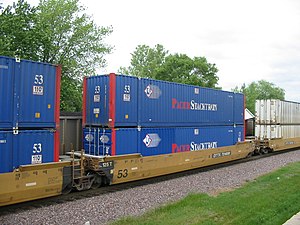
A portion of a 5-unit container car.
Template:Main
These specialized cars are designed to carry shipping containers, and in some ways resemble traditional gondolas, although their floors are usually partially open. A depressed center section provides a floor which is only inches above the rails. This stabilizes the container by lowering the center of gravity, also allowing double-stacking, which would be impossible if the containers were placed on a flatcar. Single-unit well cars exist, but 3- and 5-car articulated sets are common. These reduce weight by reducing the number of trucks by nearly half, and also reduce the amount of slack in the train since there are fewer couplers. This protects the cargo by reducing the jolts that occur at starting and stopping caused by slack.
Modalohr road trailer carriers
Specialized railroad cars carrying road trailers and road tractors on a route from France to Italy and Luxembourg to Spain and vice versa. A deck between the bogies (trucks) pivots (swings) 30°, allowing the trailers to be loaded from the sides. For details see the official sites Rail-route or Modalohr
References
- Origins of name in railroad use [1]
See also
External links
Template:Freight cars
de:Offener Güterwagen
eo:Duonvagono
ja:無蓋車
ru:Полувагон
